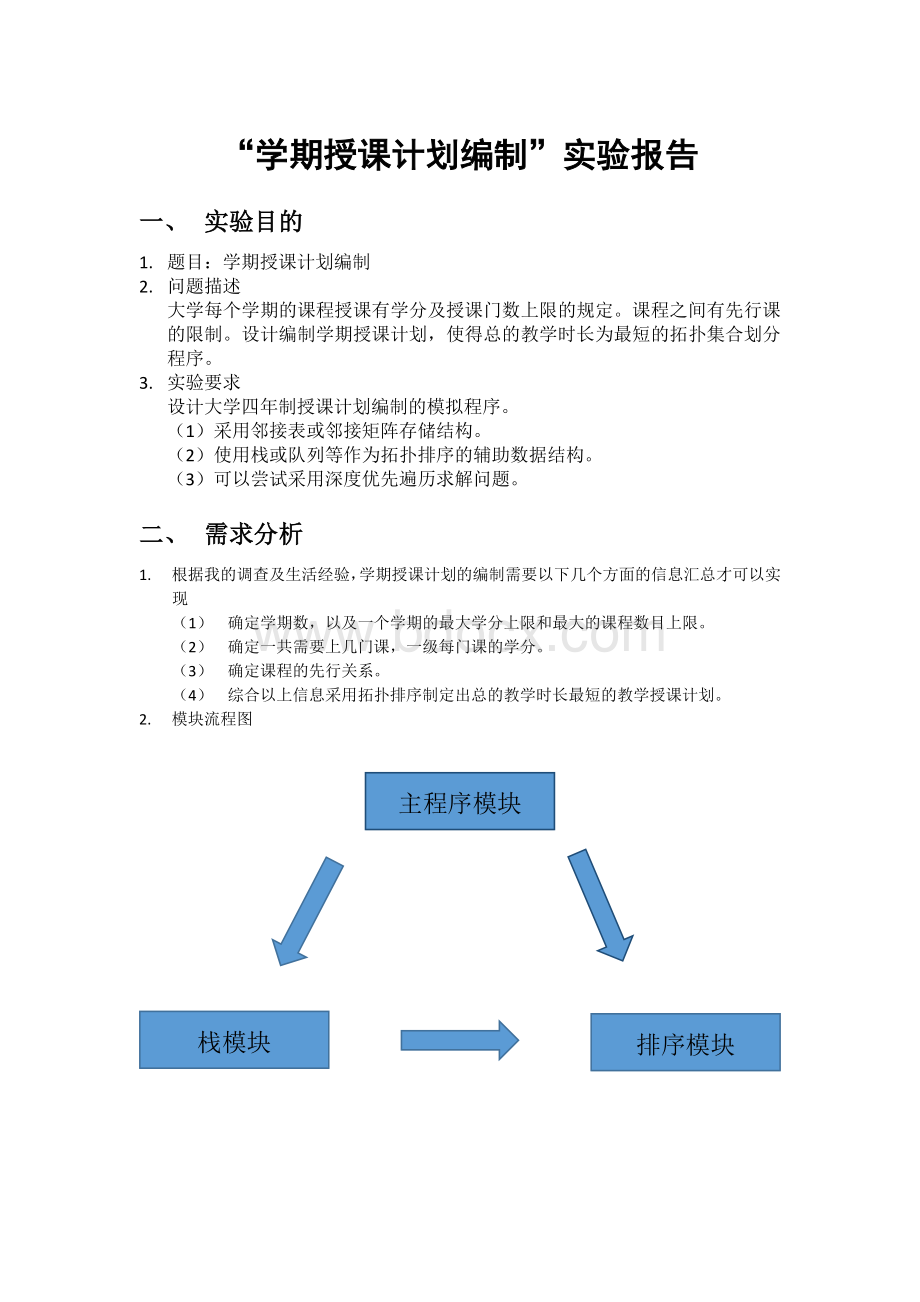学期授课计划编制Word下载.doc
《学期授课计划编制Word下载.doc》由会员分享,可在线阅读,更多相关《学期授课计划编制Word下载.doc(16页珍藏版)》请在冰豆网上搜索。

3.性能需求
本程序在运行期间,为了避免在运行大量数据时不会出错,并且能够在很短的时间内将运行结果稳定输出,就需要系统达到安全性能好,可靠性高,稳定性强,处理数据迅速等特点。
三、程序实现
本程序采取数据结构模块化编程,很好的实现了实验所要求的各项功能,本程序分为三个主要模块:
主程序模块、栈模块、排序模块。
1.主程序模块
intmain(){
printf("
学期授课计划编制\n"
);
//AOV-网:
顶点表示活动,弧表示活动间优先关系的有向图;
intCONTINUE=1;
while(CONTINUE!
=0){
printf("
------------------------------------------------\n"
ALGraphf;
//图的邻接表存储;
printf("
请输入学期总数:
"
scanf("
%d"
&
term_num);
请输入每学期的学分上限:
credit_lim);
CreateGraph(f);
Display(f);
TopologicalSort(f);
\n按1继续,按0结束:
scanf("
CONTINUE);
}
return0;
}
2.栈模块
typedefenum{DG}GraphKind;
//{有向图,有向网,无向图,无向网};
typedefstructArcNode{//弧结构;
intadjvex;
//该弧所指向的顶点的位置;
structArcNode*nextarc;
//指向下一条弧的指针;
InfoType*info;
//网的权值指针;
}ArcNode;
//表结点;
typedefstruct{
VertexTypedata;
//顶点信息;
ArcNode*firstarc;
//第一个表结点的地址,指向第一条依附该顶点的弧的指针;
}VNode,AdjList[MAX_VERTEX_NUM];
AdjListvertices,vertices2;
//分别存课程名和学分;
intvexnum,arcnum;
intkind;
}ALGraph;
intLocateVex(ALGraphG,VertexTypeu){
inti;
for(i=0;
i<
G.vexnum;
++i)
if(strcmp(u,G.vertices[i].data)==0)
returni;
return-1;
StatusCreateGraph(ALGraph&
G){
inti,j,k;
VertexTypev1,v2;
//顶点信息;
ArcNode*p;
//指向第一条依附某顶点的弧的指针;
请输入教学计划的课程数:
"
scanf("
G.vexnum);
请输入课程先修关系数(弧的数目):
G.arcnum);
请输入%d个课程的代表值(如:
c01):
\n"
G.vexnum);
++i){
%s"
G.vertices[i].data);
G.vertices[i].firstarc=NULL;
}
请输入%d个课程的学分值:
(G).vexnum);
G.vertices2[i].data);
请顺序输入每条弧的弧尾和弧头(以空格作为间隔):
for(k=0;
k<
G.arcnum;
++k){
scanf("
%s%s"
v1,v2);
i=LocateVex(G,v1);
j=LocateVex(G,v2);
p=(ArcNode*)malloc(sizeof(ArcNode));
//新建一个节点;
p->
adjvex=j;
info=NULL;
nextarc=G.vertices[i].firstarc;
G.vertices[i].firstarc=p;
returnOK;
voidDisplay(ALGraphG){
switch(G.kind){
caseDG:
printf("
有向图\n"
%d个顶点:
printf("
%s"
\n%d条弧:
G.arcnum);
i++){
p=G.vertices[i].firstarc;
voidFindInDegree(ALGraphG,intindegree[]){
ArcNode*p;
i++)
indegree[i]=0;
while(p){
indegree[p->
adjvex]++;
p=p->
nextarc;
}
typedefintSElemType;
#defineSTACK_INIT_SIZE10
#defineSTACKINCREMENT2
typedefstructSqStack{
SElemType*base;
SElemType*top;
intstacksize;
}SqStack;
StatusInitStack(SqStack*S){
(*S).base=(SElemType*)malloc(STACK_INIT_SIZE*sizeof(SElemType));
if(!
(*S).base)
exit(OVERFLOW);
(*S).top=(*S).base;
(*S).stacksize=STACK_INIT_SIZE;
voidClearStack(SqStack*S){//清空栈的操作
S->
top=S->
base;
StatusStackEmpty(SqStackS){
if(S.top==S.base)
returnTRUE;
else
returnFALSE;
3.排序模块
StatusPop(SqStack*S,SElemType*e){
if((*S).top==(*S).base)
returnERROR;
*e=*--(*S).top;
StatusPush(SqStack*S,SElemTypee){
if((*S).top-(*S).base>
=(*S).stacksize){
(*S).base=(SElemType*)realloc((*S).base,((*S).stacksize+STACKINCREMENT)*sizeof(SElemType));
if(!
exit(OVERFLOW);
(*S).top=(*S).base+(*S).stacksize;
(*S).stacksize+=STACKINCREMENT;
*((*S).top)++=e;
Statuszxf(ALGraphG){
intz=0;
for(inti=0;
i<
G.vexnum;
i++){
z+=atoi(G.vertices2[i].data);
returnz;
typedefintpathone[MAX_CLASS_NUM];
typedefintpathtwo[MAX_CLASS_NUM];
StatusTopologicalSort(ALGraphG){
inti,k,count,indegree[MAX_VERTEX_NUM];
boolhas=false;
SqStackS;
pathonea;
pathtwob;
ArcNode*p;
FindInDegree(G,indegree);
InitStack(&
S);
for(i=0;
++i){
if(!
indegree[i])
Push(&
S,i);
}
count=0;
while(!
StackEmpty(S)){
Pop(&
S,&
i);
a[i]=*G.vertices[i].data;
//课程名;
b[i]=*G.vertices2[i].data;
//学分;
pr